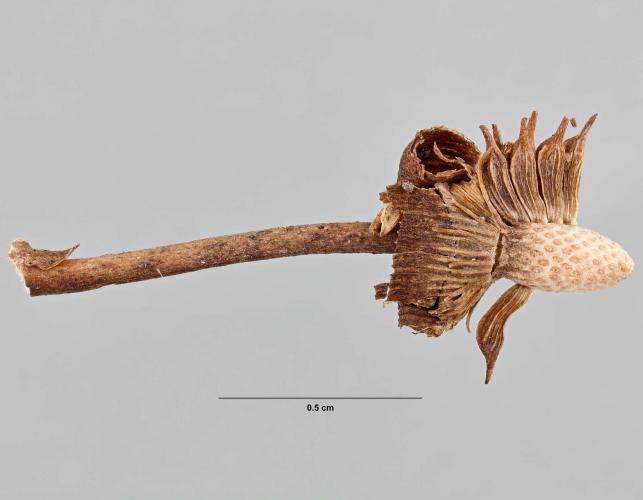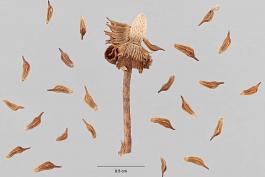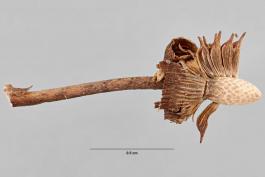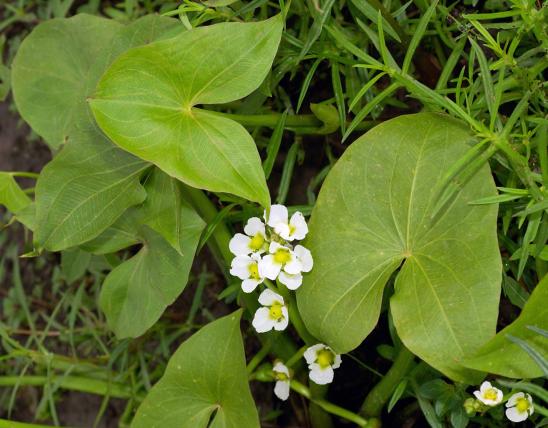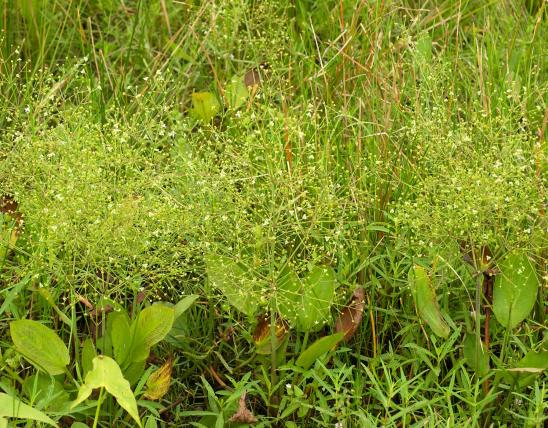
A shoreline and shallow-water plant, tall burhead is an upright-growing, annual plant with clusters of beaked seeds that develop in the fall. Hundreds of these spiny seed heads, held in clusters above the water, make it distinctive.
The leaves are extremely variable. The plants start out with ribbon-shaped underwater leaves, and as they grow, they develop shorter and wider leaves toward the top. Some of the upper leaves are floating, and some emerge entirely from the water. Submerged leaves are thin-textured with crisped margins. If you hold the leaf up the light, you can see transparent lines closely spaced together in the leaf tissue. Emergent leaf blades are usually oval, sometimes lance-shaped in small plants.
Flowers are many, small, and white, in clusters. In large plants, the flowers stalks are branched at the base. There are several whorls of 3–8 flowers. Each flower has 3 white petals. Blooms July–September. Fruits are in a globe-shaped cluster about ¼ inch wide, each fruit with a small, pointed beak.
Similar species: Two additional species of burhead (Echinodorus) occur in Missouri:
- Creeping burhead (E. cordifolius) is a creeping perennial instead of an erect annual. Its flower clusters lay horizontally when mature and do not branch, though it may root at the nodes. Scattered in eastern Missouri and along the western border, usually in the floodplains of large rivers. Most common in the Bootheel lowlands.
- Dwarf burhead (E. tenellus; sometimes Helanthium tenellum) is uncommon and known only from Howell, Scott, and St. Louis counties, on the shorelines of sinkhole ponds. It is a delicate perennial that spreads via stolons (runners). It is a Missouri species of conservation concern, ranked as critically imperiled. It has very slender leaves. In the aquarium trade, it is called pygmy chain sword or dwarf chain sword, the “chain” referring to its ability to form carpets made of individual grasslike plants, all linked together by the noodly runners (stolons).
In the same family, Missouri has 3 species of water plantains (Alisma spp.). They, too, have whorls of long-stemmed leaves with parallel veins, and tall, branched flower stalks. Water plantains’ flower stalks are more delicate and feathery; also, their seed heads are not spiny — instead, their seeds are in a ring around a flattened receptacle.
Arrowheads (Sagittaria spp.) are in the same family, too, and also live on muddy shorelines. But most of them have arrow-shaped leaves; also, their flowers are usually unisexual (having either functioning pistils, or functioning stamens, but not both, in separate flowers).
Height: usually about 1 foot; leaf length: 4–24 inches (including leaf stalk).
Scattered, mostly in counties along the floodplains of major rivers and in the Bootheel lowlands.
Habitat and Conservation
An emergent aquatic plant growing in mud along the margins of ditches, ponds, lakes, open sloughs, and rivers, often in shallow water. In the Bootheel, look for it in low, wet woodlands. Along the Missouri, Mississippi, and other large rivers, it grows in shallow backwaters. Statewide, it may occur on the margins of ponds and streams. Some people cultivate it as part of a healthy pond shoreline community on their property.
Being an annual plant, this species of burhead dies after flowering and reproduces by seeds, which germinate in spring to form new plants.
Status
Native emergent aquatic plant.
Human Connections
Tall burhead is considered a good shoreline plant for Missouri fishing ponds. It grows singly, in shallow water close to shore, and it presents few problems.
This species is sometime sold as an aquarium plant. At least 20 species of burheads have been used as aquarium plants, including the popular Amazon sword plant (E. intermedius) sold in pet stores. In addition to the live plants, usually sold to hobbyists in small pots, you can even buy plastic replicas of these iconic aquarium showpieces.
Tall burhead is likely to develop floating and emergent leaves if it receives more than 12 hours of light a day. At the same time, the lower leaves will die out. This, and its size, makes it somewhat difficult to manage in all but large aquariums, but it is well-suited for a pool or pond. In aquariums, to keep the submerged leaves alive and slow the development of emergent leaves, limit the amount of light per day.
In South America and the West Indies, burhead species have been used for a variety of medicinal purposes. Some species are used to dye cloth.
Ecosystem Connections
The seeds of burhead, like those of several other aquatic plants, are very resistant to wetting. This allows them to drift long distances on the surface of the water, making it more likely to be picked up by birds or other animals and dispersed somewhere else.
A variety of birds reportedly eat the seeds.
Burheads and other rooted shoreline plants are important for holding soils in place and preventing erosion. The maze created by the stalks and leaves of this and other shoreline plants provides valuable cover and habitat for a host of aquatic, semiaquatic, and water-loving land animals, from fish and aquatic invertebrates to frogs, salamanders, muskrats, birds, and more.


